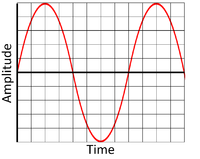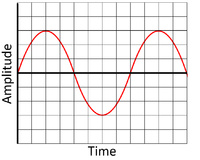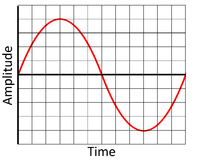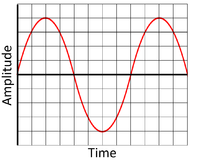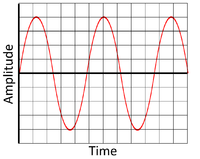Difference between revisions of "Oscilloscope"
| (4 intermediate revisions by 2 users not shown) | |||
| Line 6: | Line 6: | ||
===About Oscilloscopes=== | ===About Oscilloscopes=== | ||
: [[Oscilloscope]]s display the information on a screen with the [[amplitude]] on the [[y-axis]] and [[time]] on the [[x-axis]]. | : [[Oscilloscope]]s display the information on a screen with the [[amplitude]] on the [[y-axis]] and [[time]] on the [[x-axis]]. | ||
| + | |||
| + | {| class="wikitable" | ||
| + | |[[File:OscilloscopeScreen4.png|center|200px]] | ||
| + | |[[File:OscilloscopeScreen5.png|center|200px]] | ||
| + | |[[File:OscilloscopeScreen6.png|center|200px]] | ||
| + | |- | ||
| + | | style="height:20px; width:200px; text-align:center;" |This is a high [[amplitude]] [[wave]] on an [[oscilloscope]] screen. | ||
| + | | style="height:20px; width:200px; text-align:center;" | | ||
| + | | style="height:20px; width:200px; text-align:center;" |This is a low [[amplitude]] [[wave]] on an [[oscilloscope]] screen. | ||
| + | |} | ||
| + | |||
| + | {| class="wikitable" | ||
| + | |[[File:OscilloscopeScreen1.png|center|200px]] | ||
| + | |[[File:OscilloscopeScreen2.png|center|200px]] | ||
| + | |[[File:OscilloscopeScreen3.png|center|200px]] | ||
| + | |- | ||
| + | | style="height:20px; width:200px; text-align:center;" |This is a low [[frequency]] [[wave]] on an [[oscilloscope]] screen. | ||
| + | | style="height:20px; width:200px; text-align:center;" | | ||
| + | | style="height:20px; width:200px; text-align:center;" |This is a high [[frequency]] [[wave]] on an [[oscilloscope]] screen. | ||
| + | |} | ||
| + | |||
| + | ==Key Stage 4== | ||
| + | ===Meaning=== | ||
| + | An [[oscilloscope]] is a [[Measuring Instrument|measuring instrument]] used to [[measure]] the [[frequency]] and [[amplitude]] of [[oscillation]]s. | ||
| + | |||
| + | ===About Oscilloscopes=== | ||
| + | : [[Oscilloscope]]s display the information on a screen with the [[amplitude]] on the [[y-axis]] and [[time]] on the [[x-axis]]. | ||
| + | |||
| + | {| class="wikitable" | ||
| + | |[[File:OscilloscopeScreen4.png|center|200px]] | ||
| + | |[[File:OscilloscopeScreen5.png|center|200px]] | ||
| + | |[[File:OscilloscopeScreen6.png|center|200px]] | ||
| + | |- | ||
| + | | style="height:20px; width:200px; text-align:center;" |This is a high [[amplitude]] [[wave]] on an [[oscilloscope]] screen. | ||
| + | | style="height:20px; width:200px; text-align:center;" | | ||
| + | | style="height:20px; width:200px; text-align:center;" |This is a low [[amplitude]] [[wave]] on an [[oscilloscope]] screen. | ||
| + | |} | ||
| + | |||
| + | {| class="wikitable" | ||
| + | |[[File:OscilloscopeScreen1.png|center|200px]] | ||
| + | |[[File:OscilloscopeScreen2.png|center|200px]] | ||
| + | |[[File:OscilloscopeScreen3.png|center|200px]] | ||
| + | |- | ||
| + | | style="height:20px; width:200px; text-align:center;" |This is a low [[frequency]] [[wave]] on an [[oscilloscope]] screen. | ||
| + | | style="height:20px; width:200px; text-align:center;" | | ||
| + | | style="height:20px; width:200px; text-align:center;" |This is a high [[frequency]] [[wave]] on an [[oscilloscope]] screen. | ||
| + | |} | ||
| + | |||
| + | ===References=== | ||
| + | ====AQA==== | ||
| + | |||
| + | :[https://www.amazon.co.uk/gp/product/178294558X/ref=as_li_tl?ie=UTF8&camp=1634&creative=6738&creativeASIN=178294558X&linkCode=as2&tag=nrjc-21&linkId=f0dfb66dafcb0c6e9449e7b1a4ae1ac351 ''Oscilloscopes (generated potential difference), page 97, GCSE Physics; The Revision Guide, CGP, AQA ''] | ||
| + | :[https://www.amazon.co.uk/gp/product/1782945598/ref=as_li_tl?ie=UTF8&camp=1634&creative=6738&creativeASIN=1782945598&linkCode=as2&tag=nrjc-21&linkId=ad276ad49df77ab4b40ab4fd0fe10127 ''Oscilloscopes, page 220, GCSE Combined Science; The Revision Guide, CGP, AQA ''] | ||
| + | :[https://www.amazon.co.uk/gp/product/1782946403/ref=as_li_tl?ie=UTF8&camp=1634&creative=6738&creativeASIN=1782946403&linkCode=as2&tag=nrjc-21&linkId=32a0abb60dff015b15b50e9b1d7b4644 ''Oscilloscopes, pages 192, 203, 236, GCSE Combined Science Trilogy; Physics, CGP, AQA ''] | ||
| + | :[https://www.amazon.co.uk/gp/product/1782945970/ref=as_li_tl?ie=UTF8&camp=1634&creative=6738&creativeASIN=1782945970&linkCode=as2&tag=nrjc-21&linkId=a120d24dcc7cc7a58192069a3aafc1d2 ''Oscilloscopes, pages 227-229, 245, 304, 305, 332, GCSE Physics; The Complete 9-1 Course for AQA, CGP, AQA ''] | ||
| + | :[https://www.amazon.co.uk/gp/product/019835939X/ref=as_li_tl?ie=UTF8&camp=1634&creative=6738&creativeASIN=019835939X&linkCode=as2&tag=nrjc-21&linkId=57e96876985fc39b1a3d8a3e3dc238b6 ''Oscilloscopes, pages 65, 184-185, GCSE Physics; Third Edition, Oxford University Press, AQA ''] | ||
| + | |||
| + | ====Edexcel==== | ||
| + | |||
| + | :[https://www.amazon.co.uk/gp/product/1782948163/ref=as_li_tl?ie=UTF8&camp=1634&creative=6738&creativeASIN=1782948163&linkCode=as2&tag=nrjc-21&linkId=0fdbfd5dd397d6e24a9dfb250f08587f ''Oscilloscopes, pages 95, 339, GCSE Physics, CGP, Edexcel ''] | ||
| + | |||
| + | ====OCR==== | ||
| + | :[https://www.amazon.co.uk/gp/product/1782945695/ref=as_li_tl?ie=UTF8&camp=1634&creative=6738&creativeASIN=1782945695&linkCode=as2&tag=nrjc-21&linkId=ceafcc80bcad6b6754ee97a0c7ceea53 ''Oscilloscopes, page 187, Gateway GCSE Combined Science; The Revision Guide, CGP, OCR ''] | ||
| + | :[https://www.amazon.co.uk/gp/product/0198359837/ref=as_li_tl?ie=UTF8&camp=1634&creative=6738&creativeASIN=0198359837&linkCode=as2&tag=nrjc-21&linkId=3c4229e8b023b2b60768e7ea2307cc6f ''Oscilloscopes, pages 136, 145, Gateway GCSE Physics, Oxford, OCR ''] | ||
Latest revision as of 08:01, 15 December 2019
Contents
Key Stage 3
Meaning

A picture of an oscilloscope.
An oscilloscope is a measuring instrument used to measure the frequency and amplitude of oscillations.
About Oscilloscopes
- Oscilloscopes display the information on a screen with the amplitude on the y-axis and time on the x-axis.
| This is a high amplitude wave on an oscilloscope screen. | This is a low amplitude wave on an oscilloscope screen. |
| This is a low frequency wave on an oscilloscope screen. | This is a high frequency wave on an oscilloscope screen. |
Key Stage 4
Meaning
An oscilloscope is a measuring instrument used to measure the frequency and amplitude of oscillations.
About Oscilloscopes
- Oscilloscopes display the information on a screen with the amplitude on the y-axis and time on the x-axis.
| This is a high amplitude wave on an oscilloscope screen. | This is a low amplitude wave on an oscilloscope screen. |
| This is a low frequency wave on an oscilloscope screen. | This is a high frequency wave on an oscilloscope screen. |
References
AQA
- Oscilloscopes (generated potential difference), page 97, GCSE Physics; The Revision Guide, CGP, AQA
- Oscilloscopes, page 220, GCSE Combined Science; The Revision Guide, CGP, AQA
- Oscilloscopes, pages 192, 203, 236, GCSE Combined Science Trilogy; Physics, CGP, AQA
- Oscilloscopes, pages 227-229, 245, 304, 305, 332, GCSE Physics; The Complete 9-1 Course for AQA, CGP, AQA
- Oscilloscopes, pages 65, 184-185, GCSE Physics; Third Edition, Oxford University Press, AQA
